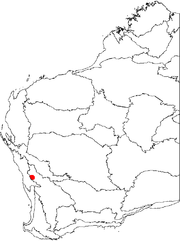
Banksia trifontinalis
Encyclopedia
Banksia trifontinalis, commonly known as Three Springs Dryandra, is a shrub
endemic to Western Australia
.
by Alex George
on 6 August 1986. George published a description of the species in 1996, naming it Dryandra trifontinalis. The specific epithet is from the Latin
tri- ("three") and fontinalis ("of a spring"), in reference to the town of Three Springs.
In 2007, all Dryandra species were transferred to Banksia
by Austin Mast
and Kevin Thiele
. Hence the current full name of the species is Banksia trifontinalis (A.S.George) A.R.Mast & K.R.Thiele.
 It occurs only in a few populations in the vicinity of Arrino
It occurs only in a few populations in the vicinity of Arrino
and Three Springs in the Geraldton Sandplains
biogeographic region. It is locally common, and grows on lateritic soil amongst low woodland.
Shrub
A shrub or bush is distinguished from a tree by its multiple stems and shorter height, usually under 5–6 m tall. A large number of plants may become either shrubs or trees, depending on the growing conditions they experience...
endemic to Western Australia
Western Australia
Western Australia is a state of Australia, occupying the entire western third of the Australian continent. It is bounded by the Indian Ocean to the north and west, the Great Australian Bight and Indian Ocean to the south, the Northern Territory to the north-east and South Australia to the south-east...
.
Description
It grows as an openly branched shrub, and can reach up to two metres high. It has long, narrow, serrated leaves, and a yellow inflorescence.Taxonomy
The type specimen was collected west of Three Springs, Western AustraliaThree Springs, Western Australia
Three Springs is located 313 km north of Perth, Western Australia on the Midlands Road. Wheat farming is the main industry.The first Europeans to pass through the Three Springs area were Lieutenant George Grey and his party in 1839. The next exploration of the area in 1846 was undertaken by...
by Alex George
Alex George
Alexander Segger George is a Western Australian botanist. He is the authority on the plant genera Banksia and Dryandra...
on 6 August 1986. George published a description of the species in 1996, naming it Dryandra trifontinalis. The specific epithet is from the Latin
Latin
Latin is an Italic language originally spoken in Latium and Ancient Rome. It, along with most European languages, is a descendant of the ancient Proto-Indo-European language. Although it is considered a dead language, a number of scholars and members of the Christian clergy speak it fluently, and...
tri- ("three") and fontinalis ("of a spring"), in reference to the town of Three Springs.
In 2007, all Dryandra species were transferred to Banksia
Banksia
Banksia is a genus of around 170 species in the plant family Proteaceae. These Australian wildflowers and popular garden plants are easily recognised by their characteristic flower spikes and fruiting "cones" and heads. When it comes to size, banksias range from prostrate woody shrubs to trees up...
by Austin Mast
Austin Mast
Austin R. Mast is a research botanist. Born in 1972, he obtained a Ph.D. from the University of Wisconsin–Madison in 2000. He is currently an associate professor within the Department of Biological Science at Florida State University , and has been director of FSU's since August 2003.One of his...
and Kevin Thiele
Kevin Thiele
Kevin R. Thiele is curator of the Western Australian Herbarium. His research interests include the systematics of the plant families Proteaceae, Rhamnaceae and Violaceae, and the conservation ecology of grassy woodland ecosystems...
. Hence the current full name of the species is Banksia trifontinalis (A.S.George) A.R.Mast & K.R.Thiele.
Distribution

Arrino, Western Australia
Arrino is a small town in the Mid West region of Western Australia. The town is located between Mingenew and Three Springs on the Midlands Road....
and Three Springs in the Geraldton Sandplains
Geraldton Sandplains
Geraldton Sandplains is an Interim Biogeographic Regionalisation for Australia region in Western Australia and part of the larger Southwest Australia savanna ecoregion.It has two sub regions: -* Geraldton Hills sub region* Lesuer sub region...
biogeographic region. It is locally common, and grows on lateritic soil amongst low woodland.

